Uploading Products to Godaddy Site Store From Template
We follow a strict honesty policy. Nonetheless, to fund our work, we utilise affiliate advertizing links on this blog.
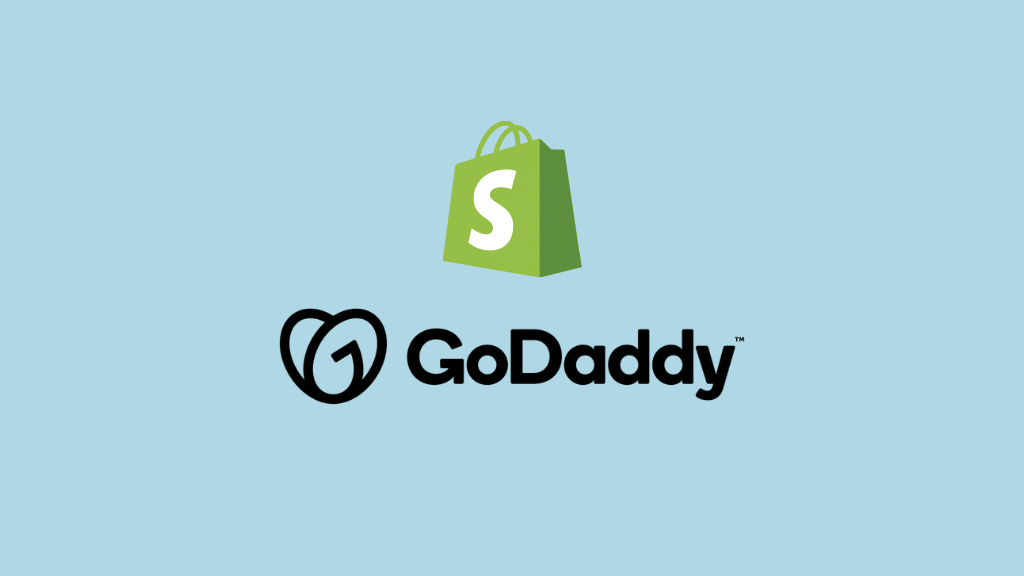
Shopify vs GoDaddy: which should you choose? In this detailed comparison, we have a look at both platforms and help you decide which is the best ecommerce solution for your business. Read on to learn more about both solutions' fundamental features, pricing, pros and cons, every bit well every bit some alternatives for building your online store.
Let's begin with a key question…
What are GoDaddy and Shopify?
On the surface, GoDaddy and Shopify look similar quite different companies, offering quite dissimilar things.
GoDaddy is best known every bit the globe'southward largest domain name and website hosting company.
Shopify is famous for being one of the most pop online store builders bachelor, used by millions of brands of all sizes to sell their products online.
However, with the add-on of website edifice and ecommerce features to GoDaddy'due south service offer, you tin can at present utilise both platforms to:
✓ create an online store (without coding knowledge)
✓ sell and ship products
✓ run marketing campaigns to promote your products
✓ sell products in physical locations.
I'm going to drill downwards into how skilful both products are at all this throughout the comparison.
But first, a quick look at the company history of GoDaddy and Shopify — and why this matters.
The groundwork to GoDaddy and Shopify
Arizona-based GoDaddy was founded in 1997 as a domain registrar and, 25 years later, it's the world'due south biggest domain name provider — with 84 million domains registered using its service, and a staff comprising over nine,000 team members.
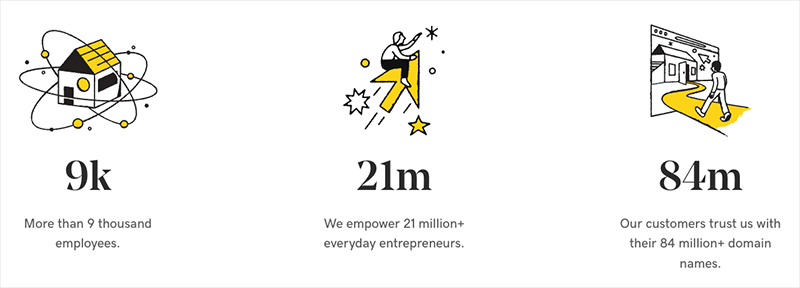
These days, however, GoDaddy offers a very wide range of online services — it's not just about domain names and web hosting whatsoever more. Among its newer ones, you can now use the platform to build a website or create an online store.
According to internet statistics company Builtwith.com, around 1.eight million websites and stores are currently powered by GoDaddy's website builder.

Shopify, headquartered in Canada, has been around since 2006 and its core focus has e'er been as an ecommerce platform for building online stores.

To appointment, Shopify has been responsible for the generation of over $450bn in sales for its users and is now used past millions of merchants (according to internet stats company Builtwith.com, information technology currently has around 4 1000000 online stores built on its platform). The company at present has a team of over 7,000 staff members.
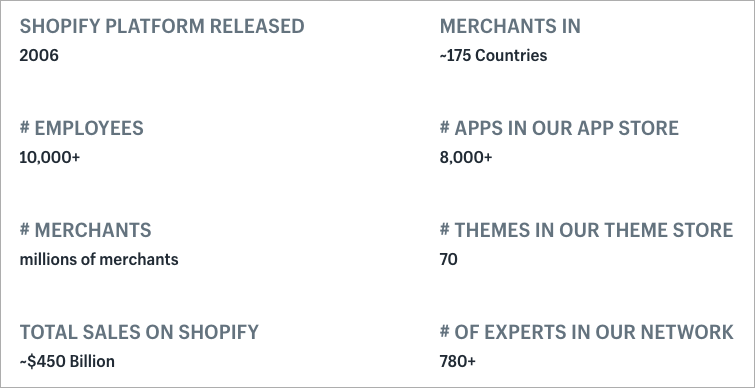
As you lot can see, both platforms have a relatively long history — and big userbases. This matters because at that place have been instances in the past where less-established platforms take gone out of business — leading to huge disruption for their users.
However, because Shopify and GoDaddy are both well-known, profitable players in the website building space, y'all tin take conviction that their platforms aren't going to disappear anytime soon.
Now, let's dive into the primal things you demand to know about both products — starting with pricing.
Pricing
GoDaddy pricing
In that location are 4 monthly pricing plans for the GoDaddy website builder available:
- Basic — $11.99 per month
- Premium — $21.99 per month
- Commerce — $24.99 per month
- Commerce Plus — $44.99 per calendar month.
The good news is that with GoDaddy, you can offset building a site or store entirely for gratuitous.
On elevation of that, you lot tin utilise your free site forever. You merely commencement paying when yous desire to avail of the features that come with the paid plans.
Additionally, GoDaddy occasionally runs discounts. At the time of writing, for US users there is a thirty%-40% discount on all plans for the first year, reducing the monthly charge for the 'commerce' plan to $xiv.99 (run into screenshot below).
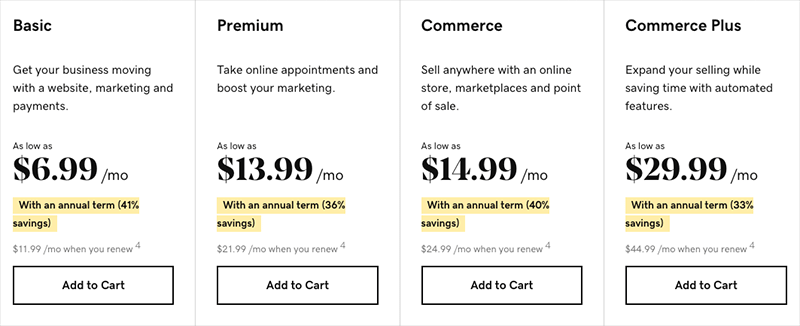
All GoDaddy pricing plans allow you to:
- create a site with its website builder
- connect a custom domain proper noun to your site
- accept online bookings
- apply 'GoDaddy Payments' (U.s. just) to sell products in a physical store
- admission marketing analytics.
As you go up the GoDaddy pricing ladder, you get access to more features.
The main differences to watch out for betwixt GoDaddy price plans are:
- Ecommerce — simply the 'Commerce' and 'Commerce Plus' plans permit yous create a fully-functional, standalone online store.
- Search Engine Optimization (SEO): the 'bones' programme does not give you access to GoDaddy's SEO features.
- Recurring appointments: the two most expensive plans allow you to let users pay for recurring events (weekly gym classes etc.) — the others facilitate '1-fourth dimension' appointment booking merely.
- Product limits: on the 'Commerce' program, you tin sell up to 5,000 products; the 'Commerce Plus' programme lets you sell an unlimited number.
- Email marketing limits: this varies co-ordinate to plan, with a monthly send limit of 100 emails and 500 emails applying on the 'basic' and 'standard' plans, respectively. This limit rockets up to 25,000 per month emails for the 'premium' and 'commerce' plans.
Although the 'Commerce' plan is the only GoDaddy plan that lets you build an online store, it's important to note that the other plans do facilitate some ecommerce.
If you're selling services that don't involve a concrete production (consultancy services or online classes, for example), yous can exercise that on GoDaddy'due south 'Premium' programme; and you can use whatever paid-for GoDaddy plan to take in-person payments or ship people payment requests.
But if yous desire to sell a catalog of physical goods on your online shop, y'all should note that only the 'Commerce' and 'Commerce Plans' let yous do this.
Shopify pricing
Shopify offers five pricing plans to choose from — and, unlike GoDaddy'south, they all permit you lot to sell concrete products online:
- Lite — $9 per calendar month
- Bones — $29 per month
- Shopify — $79 per calendar month
- Advanced — $299 per month
- Plus — custom pricing depending on requirements (but fees are ordinarily effectually $2,000 per calendar month).
You can reduce these costs by paying a i-yr or 2-yr fee for your chosen plan upfront. Doing so will reduce your fees by 10% and twenty% respectively (and, unlike GoDaddy's disbelieve, this applies on an ongoing basis).
There is as well a free 14-day Shopify trial available.
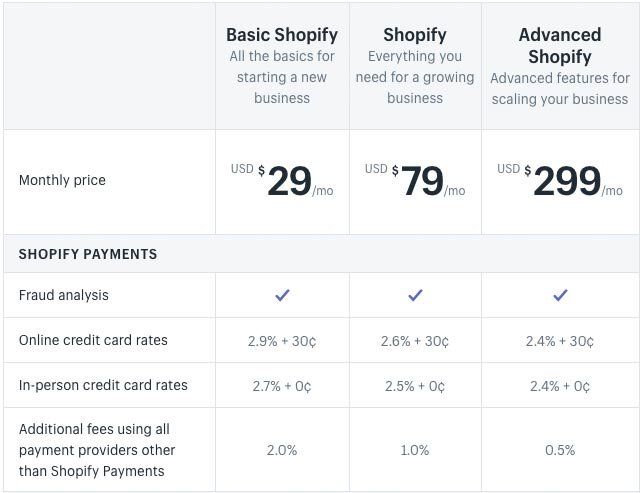
Every Shopify plan allows you lot to sell an unlimited amount of products, a major benefit for sellers with large inventories.
With the Shopify 'Calorie-free' plan, however, information technology's important to note that y'all don't get to build a standalone online store. What you do get is a certain amount of online and offline selling capability.
Online, yous can sell products on an existing online presence (websites, social media platforms etc.) by manner of the 'Shopify Buy' button, pictured below; offline, you become to sell your appurtenances in a concrete location (at a 'point of sale') using Shopify's store management tools and payment processing software and hardware.
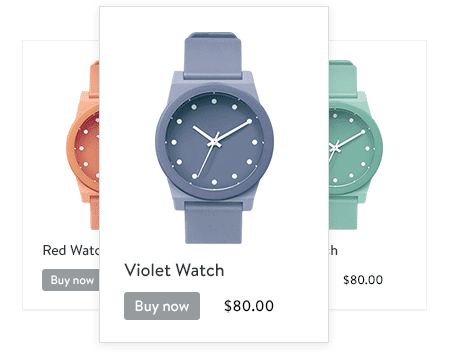
The other Shopify plans all provide you with full access to Shopify's store builder and its range of free or paid templates.
On the 'Basic Shopify' up to the 'Plus' plans, you'll get:
- the ability to create a standalone online store
- the ability to sell on online marketplaces (Amazon, Ebay etc.) and on social media
- the option to create promotional discount codes
- multilingual and multi-currency selling tools
- abandoned cart recovery tools
- integrated aircraft solutions.
The main differences between the Shopify plans involve…
- the number of staff accounts you tin can accept — two staff accounts are provided with 'Basic Shopify'; 'Shopify' gives you 5 and 'Avant-garde' lets you add 15.
- the extent of the reporting features — the most useful reports are just available on the 'Shopify' or higher plans.
- the level of multi-currency selling features — the 'Avant-garde' and 'Shopify Plus' plans permit you to set your own currency conversion rates.
Most merchants will find that all the fundamental features they need are available on the the 'Basic', 'Shopify', or 'Advanced' plans.
Still, larger ecommerce businesses may be amend served past the 'Shopify Plus' plan. This is aimed at more than corporate users, and offers avant-garde security, API, multi-currency and CRM integration tools. Whole Foods Market, Polaroid and Red Bull are but some of the well-known companies to take used 'Shopify Plus' equally their ecommerce solution.
(If you'd like to explore the differences between the Shopify plans further, please read our guide to Shopify pricing.)
OK, and so nosotros've looked at how much GoDaddy and Shopify cost.
But what most their features?
Let's drill downwards into these, starting with something very important in website edifice: visuals.
How to save on Shopify
If you lot're interested in using Shopify, you lot tin can save considerably on your subscription if you lot purchase your program in a item way. Here'southward how:
- Start a trial using this link.
- When your trial is over, choose an almanac or bi-annual plan. This gives you a x% or 20% reduction in fees respectively.
Templates
Quantity of templates
Both GoDaddy and Shopify provide a broad range of templates or 'themes' that form the ground of your site's design.
Shopify offers the smaller selection — with xv free themes and 73 paid-for premium themes on offering. The premium themes have a price range of $150 to $350.
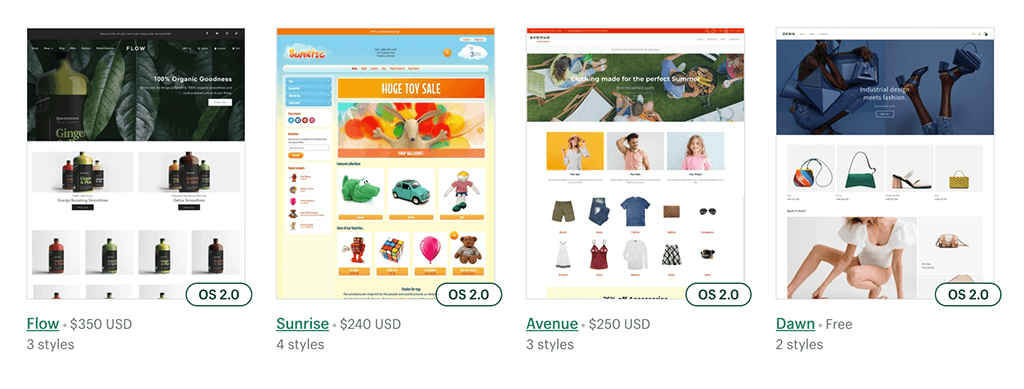
I thing to be enlightened of is that non all of the Shopify themes come in provided in Shopify's newly upgraded template format, 'Online Store 2.0.' This new format gives you a drag and drop editor that is not available in the older themes.
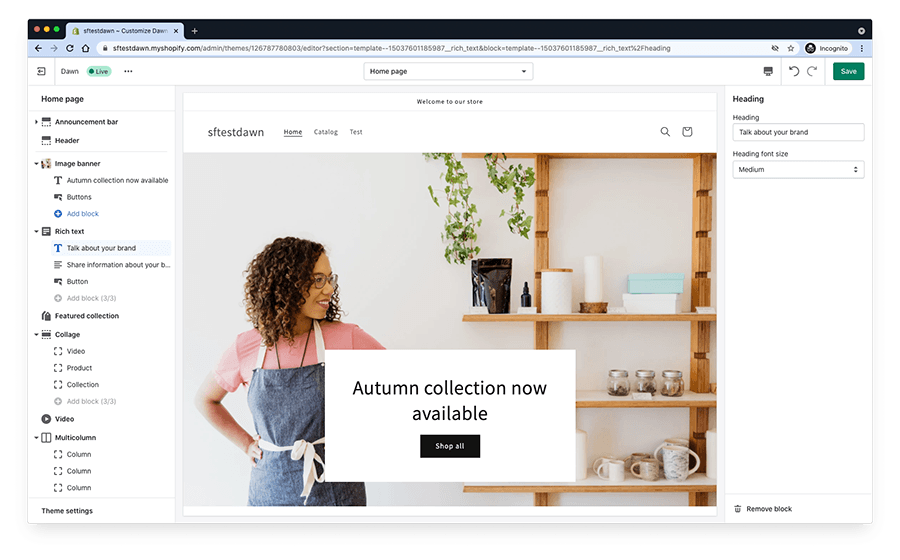
At fourth dimension of writing, Online Store 2.0 is supported in six of the xv free themes: 'Arts and crafts,' 'Crave,' 'Dawn,' Sense,' 'Studio' and 'Taste.'
Nearly all of the paid-for themes — 67 of the 73 on offer — at present back up it, however.
GoDaddy offers merely under 250 templates for its website builder. And the good news is that they are all free.

Interestingly, you don't initially choose a template for yourself when you lot sign upwardly to GoDaddy. GoDaddy asks you some questions in the onboarding process and then, based on your answers, its Artificial Design Intelligence (ADI) algorithm picks a template and creates your site for you.
If y'all're not happy with GoDaddy'southward choice nonetheless, you tin alter your template easily (more than on this later in the comparison).
Quality of templates
In terms of quality, both Shopify and GoDaddy'southward templates have a professional wait and experience, and are based on stylish combinations of text, imagery and layout design. Both sets of templates are fully responsive — this means that your store's layout volition automatically adjust itself to suit the device it'south being viewed on (telephone, tablet, desktop etc.).
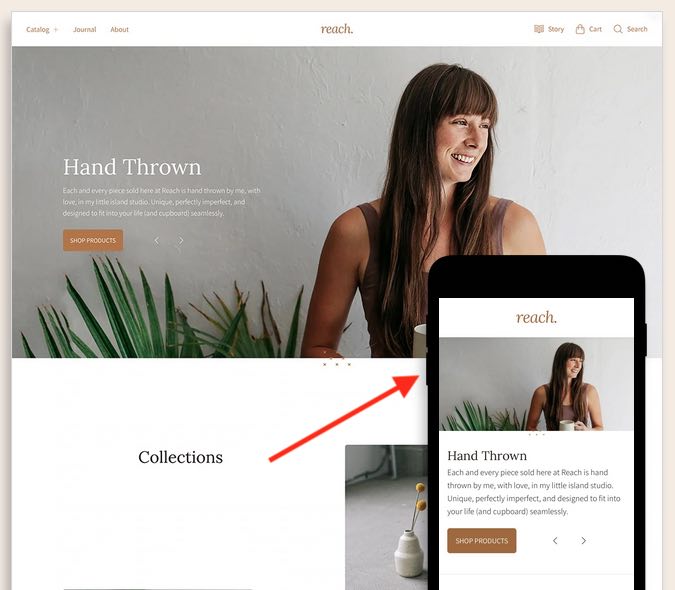
It'due south a subjective area, but for me, Shopify's templates just look that fleck more attractive; and in particular, Shopify's paid-for themes provide admission to a more sophisticated design aesthetic than anything available from GoDaddy.
That said, GoDaddy'southward templates have a respectable set of design features too. Irresolute colors is straightforward; you tin use video backgrounds on page header sections; and when it comes to text for your site, 51 typefaces are available with very easy-to-apply 'font pairing' controls.
The template section layouts all work well in GoDaddy and the lack of circuitous design options means that at that place's a minimum of fuss for the shop owner.
Overall though, Shopify has significantly more than design features available beyond its template range. More of its templates facilitate:
- parallax scrolling effects
- video backgrounds
- epitome zoom features for your products.
The lesser line on template quality is that Shopify takes the win hither.
Flexibility of templates
If you desire more than options for styling your store's template, Shopify is the more obvious selection.
For a start, you get full control of the CSS and HTML code in Shopify — pregnant you can customize your template much more extensively if you demand to. While GoDaddy lets yous add together HTML section blocks to your pages, that won't offer enough styling opportunities for many 'pro' shop owners.
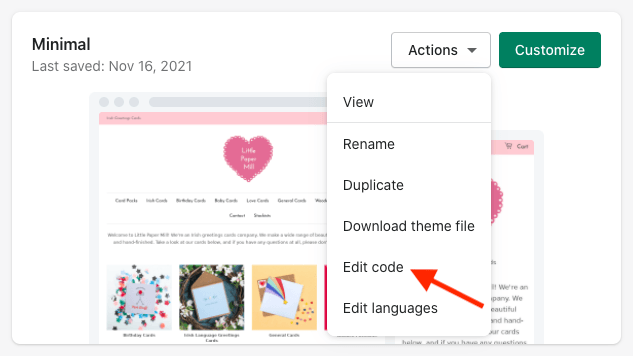
Additionally, font options are considerably more extensive with Shopify than in GoDaddy. You can choose from hundreds of bundled web fonts (to GoDaddy'due south 51), and add together your own fonts easily to your shop too — this gives you total control over your store's typography.
Finally, both platforms make information technology extremely easy to switch between templates.
In fact, with GoDaddy's editor, this literally takes two mouse clicks and your theme is changed. All y'all need to do is click a simple 'effort a new look' push and you'll see the changes — this tin can aid you test unlike styles very quickly.

But overall, if blueprint flexibility is a key requirement, Shopify is the amend platform for you lot.
Interface and content management organization (CMS)
Managing the content for your online store is a key part of running an east-commerce business, and thanks to their user-friendly interfaces, both GoDaddy and Shopify make information technology like shooting fish in a barrel to do so.
Ease-of-utilize
Both GoDaddy and Shopify's content direction systems give you a elevate and drop editor with which to add components to the pages in your online shop.
As mentioned above, however, Shopify's is only available if yous're using one of its new Online Store 2.0 templates.
Assuming you are, Shopify's editor gives yous more components and ways to lay out your store than GoDaddy'south — with Shopify, yous become more control over content layout, image formats and text positioning.
This means that GoDaddy's editor is the more simplistic of the two — with less options visible in any one view. On the plus side, this makes information technology clutter-free and intuitive (it is also visually pleasant with a 'dark mode' default blueprint).
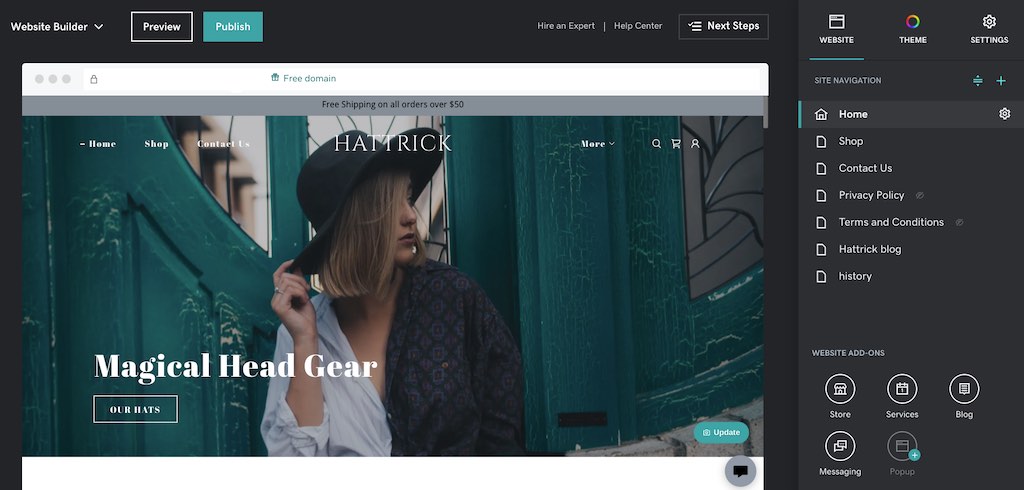
Both interfaces piece of work in a similar way — with menus on one side of the screen containing controls that let yous tweak your site'due south content. The main deviation here is that the key Shopify controls are positioned on the left, and the ones in GoDaddy are positioned on the correct.
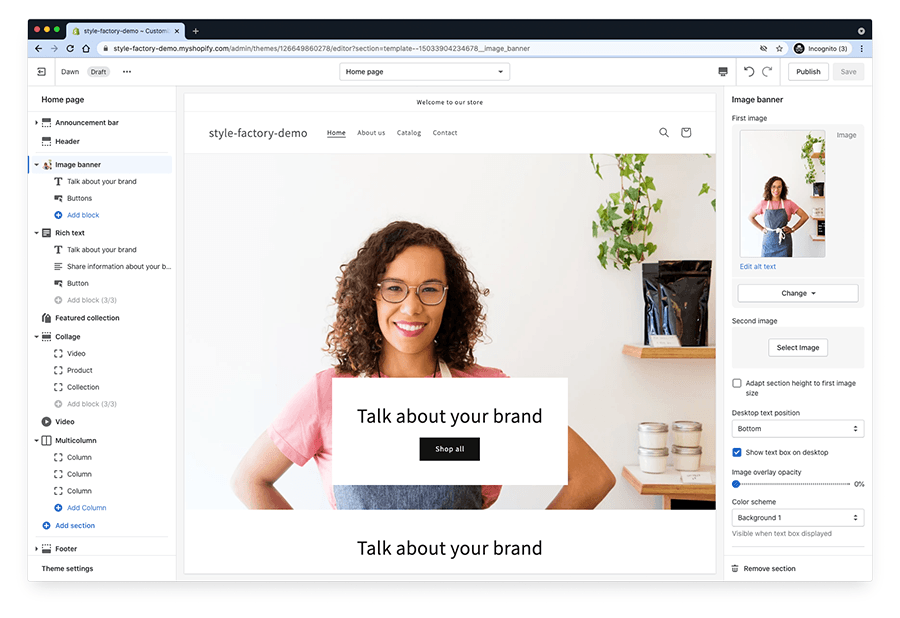
Overall, the ii approaches to content direction are strong — with Shopify's CMS existence more powerful, but GoDaddy's arguably a chip easier to hit the ground running with.
Importing and exporting content
It's very straightforward to majority import and consign products with GoDaddy and Shopify — both platforms permit you to do this using a CSV file.
It's besides like shooting fish in a barrel to manually add products to the 2 platforms — y'all just fill in a few fields, add an image or two, and your product is set up to go.
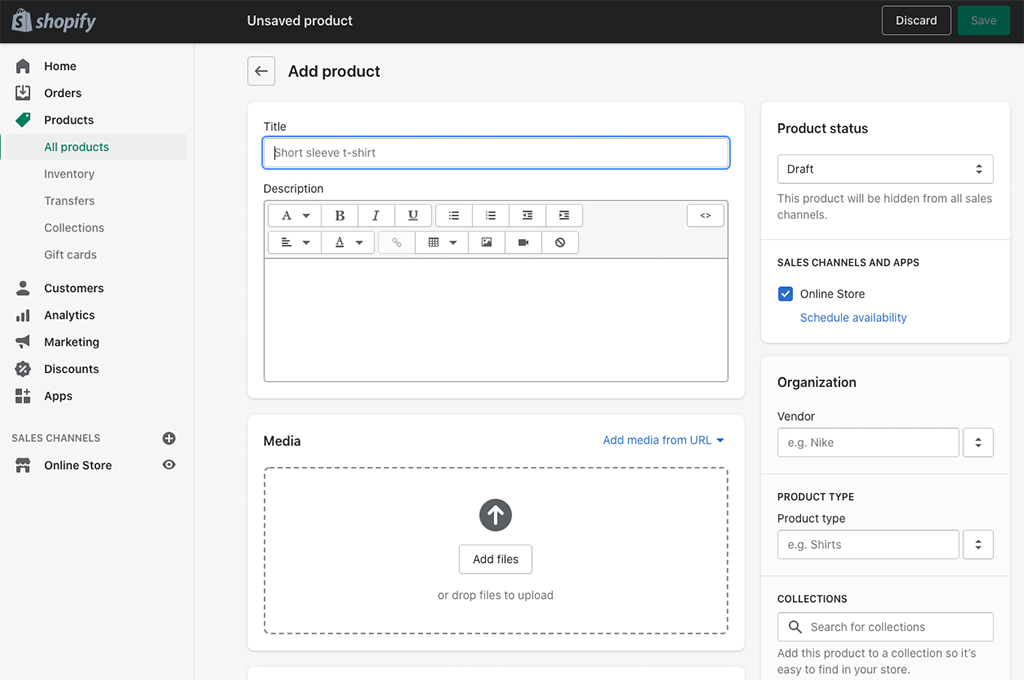
When information technology comes to web pages and blog posts, importing and exporting is doable in Shopify past way of third-political party apps (for example Blogfeeder or Excelify) — but every bit these are non role of Shopify's 'out of the box' offer, fees tin utilize.
Unfortunately, there is no like import / export option for pages and posts available from GoDaddy.
Images and galleries
You can manipulate and edit your images easily in both GoDaddy and Shopify. Of the two platforms, GoDaddy has a slight edge here.
First, adding images to your site is extremely like shooting fish in a barrel in GoDaddy. And when it comes to manipulating these images, you'll find that GoDaddy's integrated image editing program, 'GoDaddy Studio', is a very potent piece of kit — with excellent cropping, filtering, and background removal tools built in.
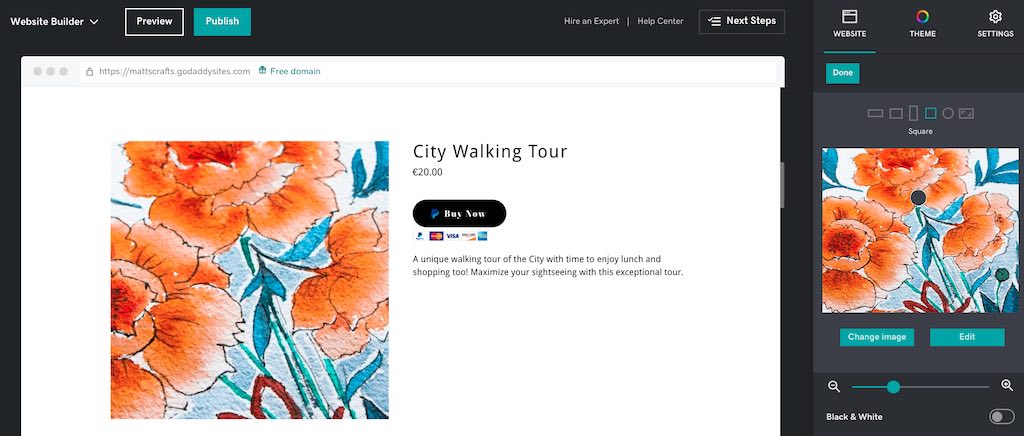
Second, resizing images then they brandish perfectly is a delight in GoDaddy'southward designer. All you lot have to do is click on the epitome on the canvas, which opens up the resizing and scaling controls in the side menu. You can then alter the fit or calibration of your image through different ratios or by dragging a slider. Information technology'southward really very useful.
Now, Shopify also has an paradigm editor and, for the most part, it gets the chore done. It'southward only not quite a slick every bit GoDaddy's.
When information technology comes to galleries for displaying multiple images on your site, GoDaddy provides 8 types of gallery out of the box that will cover most use cases for bones stores.
Out of the box, Shopify lets you add together collages, banners and slideshows to pages which let you lot to display multiple images in a reasonably flexible mode. If these don't meet your requirements, Shopify's app store gives yous access to more than 200 gallery apps (many of them gratuitous).
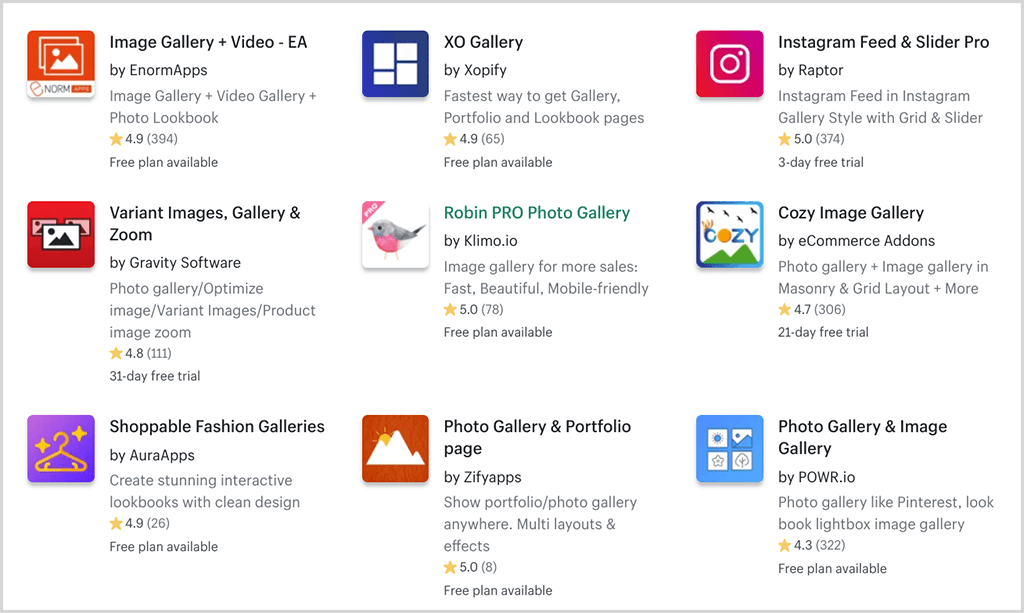
And so overall, if you want a big range of options for image galleries, Shopify is the ameliorate option. Merely when it comes to editing your images, it'south a win for GoDaddy.
Blogging
Blogging is an excellent way of making people enlightened of your ecommerce business. High-quality blogging can help your site perform well in search results, as well as drive people into your sales funnel and catechumen them into customers.
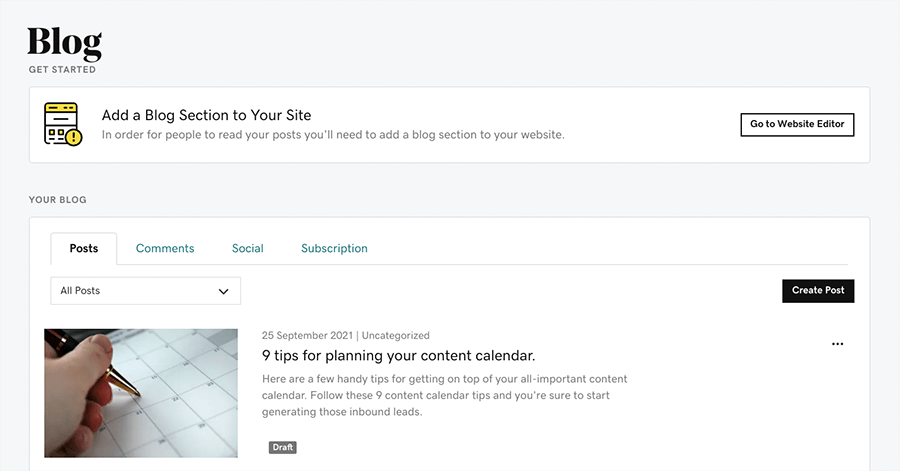
Yous can add a blog to your site in both GoDaddy and Shopify, and both platforms provide a similar level of blogging functionality — it's a draw in this section.
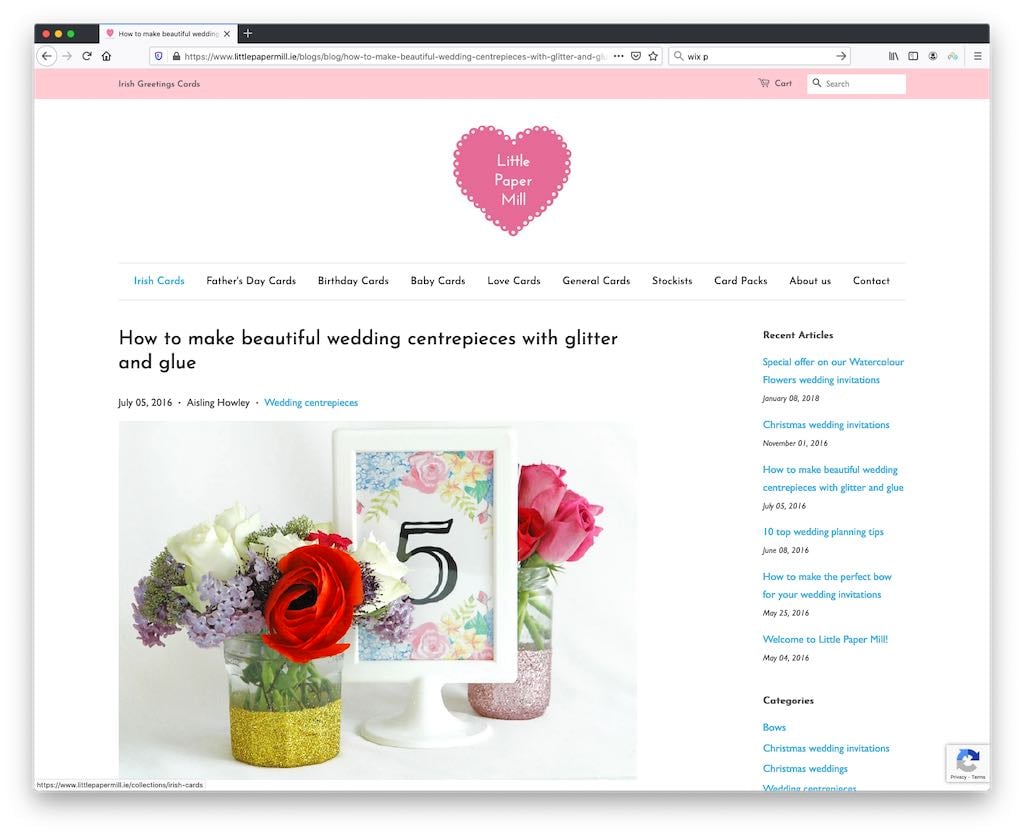
The master limitation of both platforms' blogging features involves categorization — whereas professional person blogging platforms like WordPress allow you use categories, tags and custom post types, and permit you lot to dispense and display your blog content in all sorts of wonderful ways, GoDaddy and Shopify limit you lot to either categories (GoDaddy) or tags (Shopify).
The features on offer volition be fine for virtually users, however.
Version history and backups
When it comes to bankroll upward your shop, GoDaddy provides the better features.
Firstly, GoDaddy'due south platform automatically saves changes to your site for you — unlike with Shopify, you lot don't have to hit save all the fourth dimension to save your content.
What's more, if yous brand pregnant changes to your site, GoDaddy immediately creates a total fill-in for you (yous tin also practice this manually if preferred). It'due south very simple to revert to a previous version of it.

With Shopify, past contrast, you basically have to use a third-party app to back up your store.
So information technology's a win hither for GoDaddy.
Managing media
Managing your media can be done easily in both GoDaddy and Shopify.
With Shopify, you'll observe your media in the 'files' department of your shop admin. You're allowed 250 images per product; and your image files must be no more than than 20MB in size.
For production videos, you tin can either make apply of embedded files — for example YouTube or Vimeo videos — or upload your own videos.
Limits utilize to how many videos you tin can upload to Shopify, only these are generous. Fifty-fifty on the 'Basic' plan, you tin upload 250 1GB videos to your store.
With GoDaddy, your media lives in the 'media library'. Y'all're only able to add 10 images to any one product (with a maximum file size of 10MB per image applying). For video, at that place is a 5GB limit for your entire store.
And then overall, when it comes to product media, Shopify is the more flexible choice.
Mobile apps
Shopify and GoDaddy both give you ways to manage your store on the get, via their mobile apps.
GoDaddy has multiple apps that chronicle to its wide portfolio of business activities, but the one you'll need for managing your site is simply called 'GoDaddy'.

You should note withal that this app is currently simply available in the Us.
The GoDaddy app allows y'all to comprehensively track site activity and product orders from your telephone. Information technology works seamlessly with GoDaddy Payments — GoDaddy's built-in payment processor — and it also offers almost all of the functionality of the desktop version of the website builder.
User reviews of this app are mostly positive — the Android version is rated 4.1 out of five, while iOS users charge per unit information technology most full marks, with iv.eight out of 5 in the Apple shop.
Like GoDaddy, Shopify provides several apps, but the two main ones you'll need most for managing your store on the go are 'Shopify' and 'Shopify Point of Sale.'
The main 'Shopify' app lets you perform basic due east-commerce tasks — view orders, manage inventory etc. It is currently rated 4.6 and iv.two out of 5 on the Apple tree and Google Play app stores respectively.

The 'Shopify POS' app lets you utilize the Shopify bespeak-of-sale system to sell goods in a physical location and sync your inventory with your online store.
This is less of a hit with Android users — its current rating on the Google Play store is three.two out of 5. Many complaints mention connectivity problems.
However, iOS users give information technology a college score of 4.five out of 5.
Ecommerce functionality
If you're comparing GoDaddy against Shopify, y'all are probably especially curious about which of these products is the better option for selling online.
Then, let'southward compare their e-commerce features and notice out — starting with payment processing.
Payment gateways and transaction fees
To process payments on an online store, you need a 'payment gateway'. This is the software that verifies credit bill of fare details and takes payment using them.
Both GoDaddy and Shopify offer their ain, born payment gateways: 'GoDaddy Payments' and 'Shopify Payments' respectively.
GoDaddy Payments charges a credit card processing fee of 2.iii% + 30c per transaction; Shopify Payments fees vary by plan and by country (in the United states you can expect to pay between 2.4%+30c to 2.9%+30c for online payments).
However, Shopify Payments is bachelor in considerably more than countries than GoDaddy Payments — the latter is limited to use in the U.s. for now.
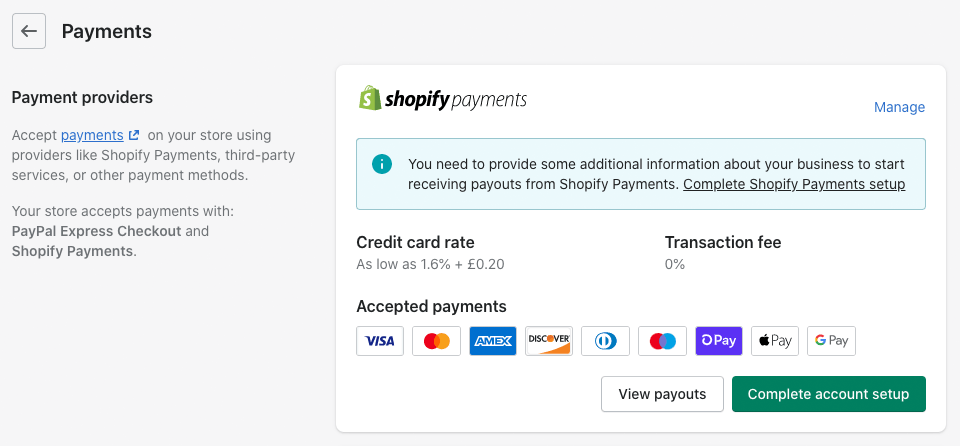
The culling to using the born payment processing options in GoDaddy and Shopify is to brand use of an external payment gateway. As with the congenital-in options, external payment gateways charge a pct fee of every transaction made through your online shop (and some charge a monthly fee, too).
Now, GoDaddy just offers integration with 3 external payment gateways — Paypal, Stripe, and Square. (And Square but works for users in Commonwealth of australia, Canada and the UK.)
Shopify works with many more, still — over 100.
The central affair to watch out for here is the fact that yous'll pay an boosted fee to Shopify for every transaction processed past a third-party payment gateway — this ranges from 0.five% to 2.0%, depending on your plan.
Past contrast, GoDaddy does non charge you or take a cut of your sales in addition to the charges you pay for your payment gateway.
The takeaway here is that Shopify offers much more flexibility around payment gateways — but that this comes at a price.
Product options and variants
Y'all tin sell an unlimited number of products on every Shopify plan. GoDaddy caps the number of products you tin sell at v,000 on its 'Commerce' program, merely lets y'all sell an unlimited number on its 'Commerce Plus' plan.
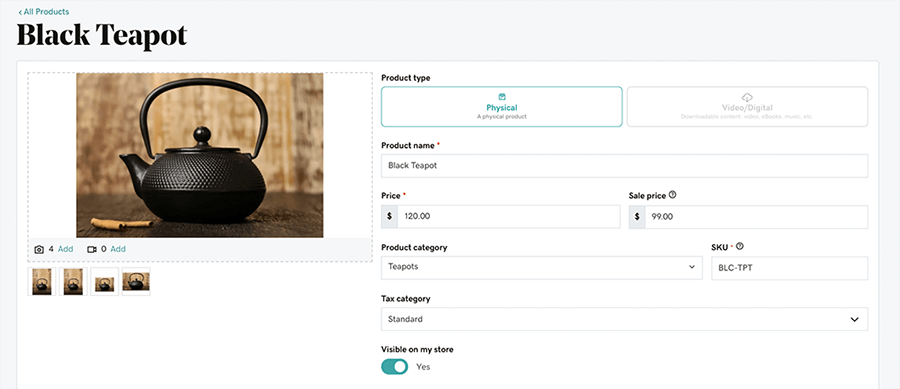
In terms of the number of product options and variants you can use, the two platforms are identical. They both allow you to make utilize of 3 product options and 100 variants.
(Production options are things similar size, material and colour. Variants are combinations of those options — for example a red leather shoe would count equally i variant, a blue suede shoe would count equally another, etc.).
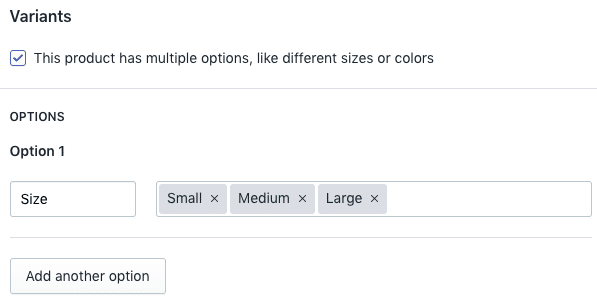
Thank you to Shopify's app store, information technology is possible to extend these limits fairly easily by adding 3rd-party apps to your store ("Infinite Options" being a popular option). It'south not actually possible to do this with GoDaddy, withal.
Overall, the standard 'out of the box' offerings from GoDaddy and Shopify will encompass well-nigh store owners' requirements when it comes to product options and variants — but some merchants may detect them a bit restrictive.
There are other platforms out in that location with more generous approaches to production options and variants. For example, Squarespace allows 6 product options and 250 variant combinations. With Ecwid, in that location are no limits to production options at all — providing sellers with big pick sets far more than freedom without having to pay extra or seek workarounds.
Selling digital products
Both GoDaddy and Shopify permit you sell digital products easily.
GoDaddy treats digital products no differently to concrete products (so if you're on its 'Commerce' plan, you should note that they course part of your 5,000 product limit).
And the process for adding a digital production to your store is largely the same equally when adding a concrete one.
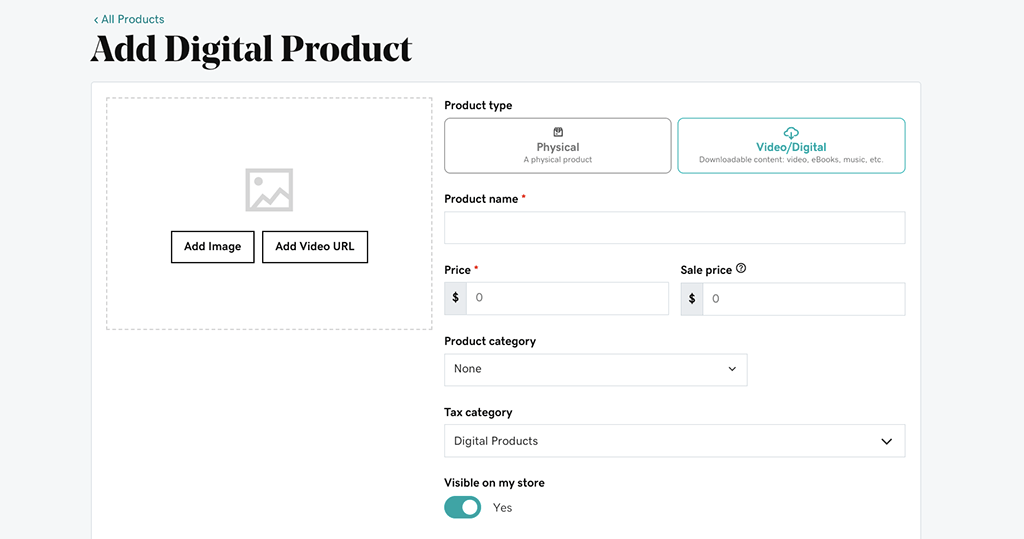
GoDaddy allows you to bundle 10 split up files into each digital product, with a 2GB limit per file applying. This adds upwards to a very generous file size limit of 20GB per production.
In Shopify, there is a quick step to take before you tin can add together your digital products to your shop — you take to add together its complimentary 'Digital Downloads' app.

In terms of file size limits, Shopify permits selling files upwards to 5GB in size.
Yous'll find an additional range of digital download apps available through the Shopify app store for farther functionality.
For example, the SendOwl app lets you postage PDF files with your customer's name — a great way to reduce fraud. It also lets you 'drip release' digital products to your customers over time, and information technology even gives you a brandable video player that your customers tin can use to stream files with.
The SkyPilot app lets yous bundle digital and physical products together, and sell files of up to 5TB in size.
Overall, both platforms will cater to most sellers' needs for getting their digital downloads out there — with Shopify giving the extra adequacy for digital download specialists through its app store enhancements. GoDaddy wins when it comes to 'out of the box' file size limits, however.
Shopify and not-fungible tokens (NFTs)
Interestingly, in addition to letting you sell regular digital files, Shopify is at present beta-testing some functionality for minting and selling non-fungible tokens (NFTs).
NFTs are 'unique', gated files that can't be replaced; and they can stand for anything digital — art, animated stickers, music, video and more.).
In that location isn't currently a similar characteristic from GoDaddy available.
Abandoned cart features
Abandoned cart functionality allows online sellers to identify and communicate with customers who add a product to their shopping cart but don't complete the checkout process.
Both GoDaddy and Shopify provide abandoned cart features that allow you lot to send an automated follow-up email to visitors who don't consummate a buy (y'all can include a discount code in this message to encourage them to do so). Setting this upward is easy in both platforms.
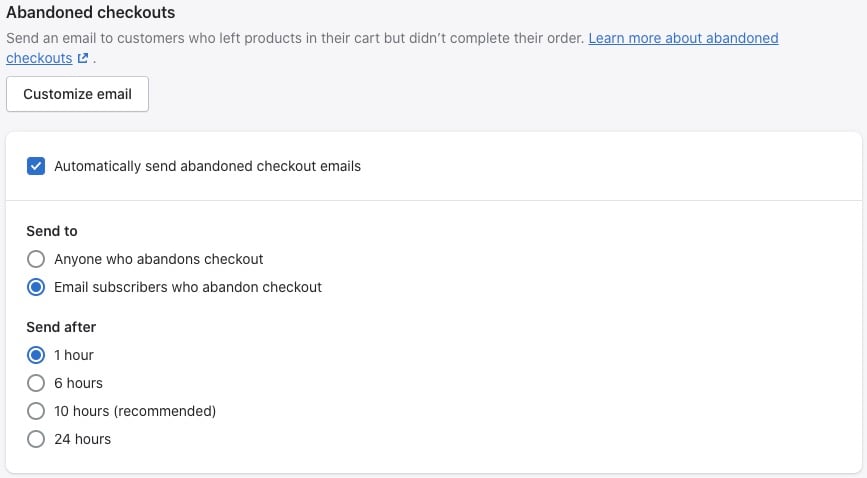
Shopify includes this feature on its $nine 'Lite' plan and all higher plans. With GoDaddy, you simply have a cart if y'all're on its $24.99 or 'Commerce' $44.99 'Commerce Plus' plans — so technically, yous can go access to abandoned cart features for less with Shopify.
Point of sale functionality in Shopify vs GoDaddy
Indicate of sale (POS) features let yous utilize your online shop to sell in physical locations similar festivals, pop-upwards shops and brick-and-mortar stores.
POS hardware includes carte readers, barcode scanners and cash registers; these enable you lot to accept payments in person whilst keeping your inventory information fully up to engagement in your ecommerce website'due south dorsum end.
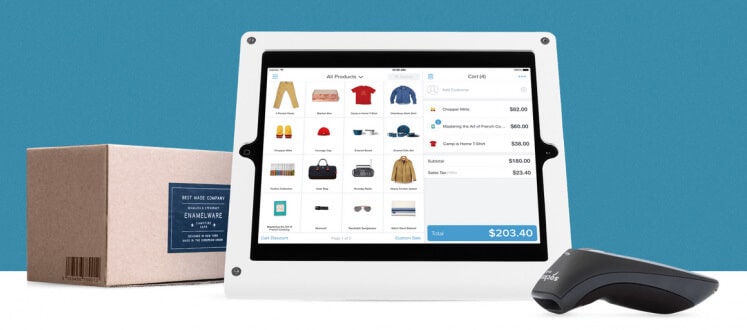
With GoDaddy, if yous are based outside the US, you'll take to use POS equipment provided by one of the platform'south three payment gateway providers (Paypal, Stripe, and Square).
However, GoDaddy merchants in the US can make use of GoDaddy's own POS hardware (menu readers and screen terminals are bachelor). United states users tin can also apply GoDaddy's mobile app every bit a 'virtual terminal' for accepting card payments on a phone or tablet.
The costs for GoDaddy's POS hardware are as follows:
- smart terminal — $249
- menu reader — $49.
Information technology's worth pointing out that GoDaddy's POS system can exist used on whatever of its 4 website plans. You don't actually need to be on the 'commerce' plan to commencement selling in person.
As for Shopify, it has been a POS leader in the ecommerce world for many years. So there is a much wider range of POS hardware on offer from Shopify than from GoDaddy, and you can utilize it in a lot more than countries.
Some of these extra options include:
- cash drawers — $139-$159
- scales — $40-$89
- receipt printers — $299-$369
- tablet stands — $99-$219
- printed gift card sleeves — $59 for 200 cards.
The bad news is that to make the most of some of Shopify'due south more sophisticated POS features, you will need to add together its 'POS Pro' addition.
This allows you to use unlimited registers, facilitate exchanges, attribute sales to staff members and exercise much else besides, merely at a fairly loftier cost — 'POS Pro' is priced at $89 per month per location.
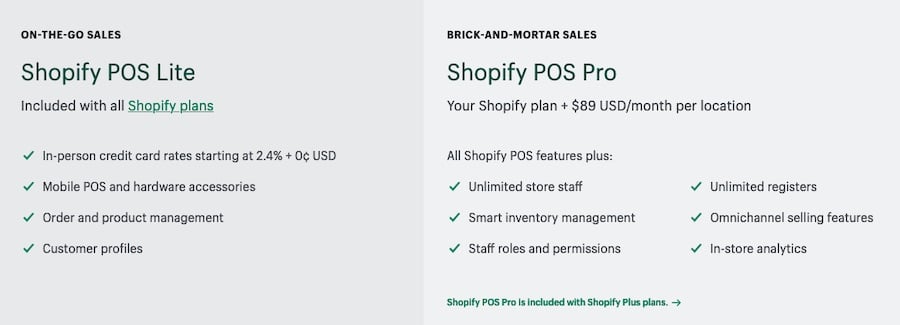
However, for elementary POS applications, the built-in point-of-sale features ('Shopify POS Lite') will be more than than adequate for most.
So, all in all, Shopify has the stronger POS offer — it has more hardware, and it's bachelor in more locations.
Shipping
When information technology comes to aircraft your products to your customers, Shopify is a lilliputian scrap more flexible than GoDaddy. It allows you to set:
- free shipping rates
- apartment rates
- cost-based rates
- weight-based rates
- calculated ('real time') shipping rates.
GoDaddy lets you lot provide:
- gratuitous shipping
- flat rate aircraft
- weight-based shipping
- calculated shipping.
(Both platforms also allow you to provide in-shop pickup options to your customers.)
Shopify has an edge when it comes to how calculated carrier-based shipping works. This is because its built-in 'Shopify Shipping' service non only facilitates existent-time shipping quotations, only gives generous discounts to users based in the The states, Canada and Commonwealth of australia — up to 88%.
GoDaddy also provides some aircraft discounts, but only to Usa users via USPS, and but if you have a Shippo business relationship.
Additionally, Shopify gives you — for an additional fee — the option to apply your own third-party carriers for calculated shipping rates. This feature works in any country, whereas GoDaddy's realtime shipping features are limited to the U.s.a. and Canada.
Dropshipping
Dropshipping is a style of selling where you accept an gild, transport it to a supplier, and they deliver the production to your customer — you don't brand, store or fulfil whatsoever goods, which can reduce outlay enormously. This makes information technology a very popular online selling technique.
Shopify provides a very large number of integrations with dropshipping companies through its app shop (which we'll discuss shortly) — 422 dropshipping-related apps are currently bachelor.
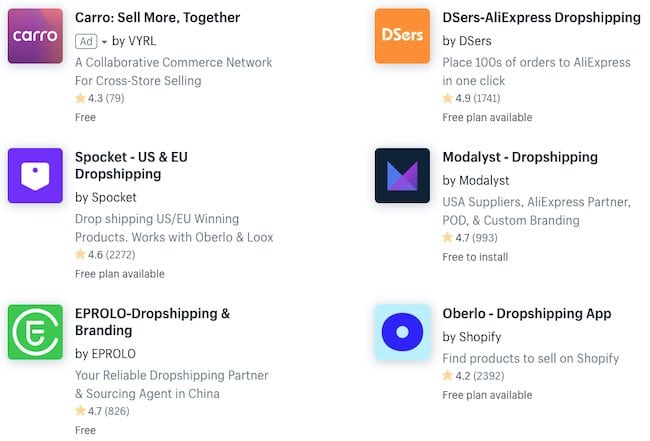
With GoDaddy, whilst information technology'southward technically possible to dropship through its platform (you could simply take orders and pass them onto a supplier of your choice), there are no dedicated dropshipping features that automate or simplify the process.
Then, if you want to set upwardly a dropshipping business, the better option here is definitely Shopify — it gives you everything you need to source and supply dropshipped goods.
The Shopify dropshipping starter kit
If you're interested in dropshipping, I'd recommend that you have a look at Shopify's dropshipping starter kit — with this, you get 14 days of free admission to Shopify plus lots of arranged resources and tools that bear witness y'all how to launch a successful dropshipping Shopify store.
Personalising products
One area where GoDaddy has a definite advantage over Shopify involves how information technology lets yous personalize products.
Its 'product add-on' feature allows you lot to create bespoke form fields to grab specific information from your customers relating to individual products in your store. This is very useful for sellers providing personalizable products like engraved jewellery.
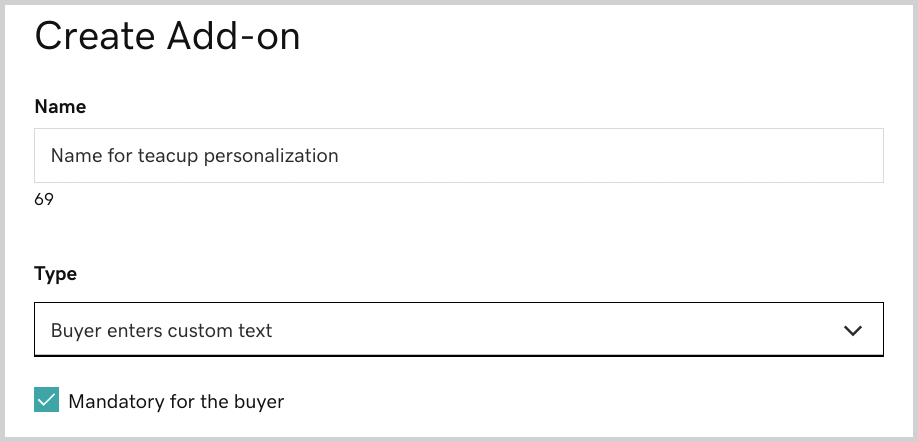
To add an equivalent personalization field in Shopify, you'll need to practice some coding or make use of a 3rd-party app.
And then a win on this front end for GoDaddy.
Multi-currency selling
Displaying prices and facilitating checkout in your shop visitors' own currencies tin can improve sales rates considerably.
So, how easily can you practise this with GoDaddy and Shopify?
Well, on a GoDaddy store, your options for displaying dissimilar currencies are very limited.
Whilst GoDaddy does work with 18 different currencies, y'all tin can only cull ane to use on your store. This is fine if you only always intend to sell your products in ane market, just if yous have ambitions to sell in multiple territories, information technology'southward not ideal.
That said, GoDaddy can assist you with making international sales and then long equally you are based in the United states, and if you employ one of its marketplace integrations. GoDaddy integrates very neatly with:
- Amazon
- Etsy
- Ebay
- Google Shopping
- Walmart.
(If you're in the Great britain and Australia, you lot currently only get access to the eBay integration; simply access to the Amazon one for users based in those countries should exist arriving later in 2022. Canadian users currently go access to Amazon and eBay integrations).
When your products evidence up in these marketplaces, they are automatically shown in the currency of the company visiting the marketplace.
Now, multi-currency selling with Shopify — while not perfect — is far amend.
Its new 'Shopify Markets' characteristic lets yous define selling areas (based on countries) and associate specific currencies and languages with them. If a user is in a item market, they will be prompted to switch to the currency you've defined for that marketplace (annotation that if they get on to make a purchase in that currency, a ii% currency conversion fee will apply to the auction).
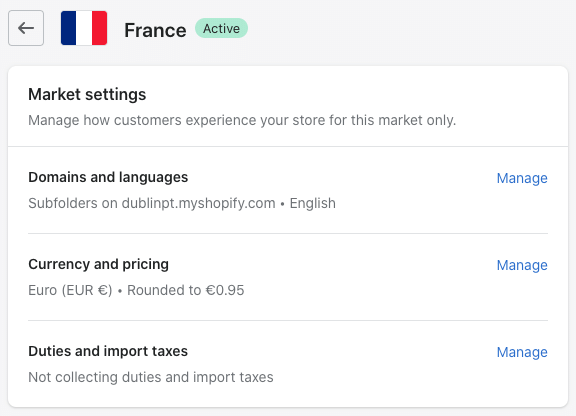
If this 'prompt arroyo' doesn't appeal, y'all accept the option of using a third-party app to give your store fully automatic currency conversion — where instead of nudging your site visitors to modify currency, your store just does it for them based on their IP address. The Bold Multi-Currency app (pictured below) is a good option for this.

(Alternatively, and if you take deep pockets, you could subscribe to a 'Shopify Plus' plan, which includes fully automated currency conversion).
Finally it'southward worth noting that the 'Shopify Markets' feature simply works if you are a Shopify Payments user, and you tin just set custom prices for particular markets if you lot are on an 'Advanced' or 'Shopify Plus' plan — both of which are expensive.
So there's room for improvement hither, but in the context of a GoDaddy vs Shopify shootout, when it comes to multi-currency selling, Shopify is the winner.
Multi-lingual selling
Of the two platforms nether review, just Shopify lets you sell in other languages. All plans except 'Lite' let y'all sell in upwards to 20 languages (again equally office of the new 'Shopify Markets' characteristic).
When you create a version of your Shopify shop site in a new language, its domain volition end with a binder reference to the language in question— myshop.com/fr/ for French etc., myshop.com/de/ for German etc. If you prefer, you can apply country level domains besides (i.due east., myshop.fr or myshop.de).
Unfortunately for GoDaddy users, there is no multilingual functionality available at all — so it's another clear win for Shopify hither.
Tax calculations
Automatic revenue enhancement calculation is another area where Shopify offers the better features.
WIth Shopify, nearly users can avail of automatic revenue enhancement calculation for their products — and on all plans too. Figuring out individual revenue enhancement calculations can exist massively time intensive, so Shopify's tax calculation feature is a great asset for online sellers.
If you're on its 'Commerce' plan GoDaddy requires a manual sales tax setup process for each and every production in your store.
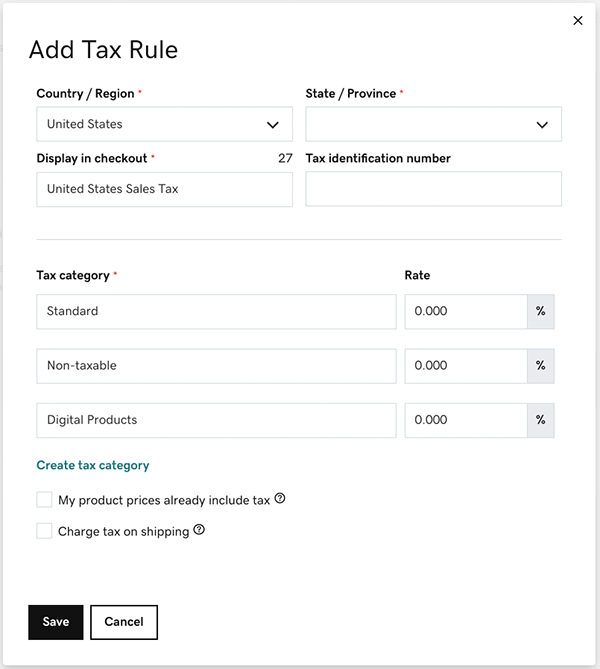
Yet, with the introduction of its 'Commerce Plus' plan, GoDaddy now offers automatic tax calculation for merchants based in the US, Canada, Commonwealth of australia in Europe.
Shopify has a item advantage over GoDaddy when it comes to applying tax rates to digital products — particularly where European union customers are concerned.
In the European union, digital products are subject to a revenue enhancement called VAT MOSS (Value Added Tax Mini One Stop Shop). This requires sellers of digital products to consumers in the EU to apply tax on these products on a country-by-country basis.
Shopify automates the calculation of VAT MOSS on digital products via its free 'Digital Downloads' app. With GoDaddy withal, it'south a matter of entering the relevant rate for each EU state, one at a time.
Analytics
If yous're running an ecommerce business concern, understanding how your users behave and interact on your site is admittedly essential.
At present, it'southward relatively easy to set upwards Google Analytics with both GoDaddy and Shopify — allowing you to get to know your customers' behavior and mensurate all sorts of traffic data.
But what virtually the analytics features each platform provides 'out of the box'?
Well, GoDaddy provides you with a personalized analytics tool called 'GoDaddy Insights'. This 'smart tool' provides you with statistics on:
- the number of site visitors
- the number of sales through your site
- social media effectiveness
- customer appointment
- reviews of and comments on your company.
On top of all that, GoDaddy Insights makes industry-specific recommendations based on information from competitors in your sector.
These recommendations come in the form of an action program; you as well get an 'insight score' out of 100 which lets yous know how your site compares against those of your competitors. All this is very useful for store owners who lack experience in digital marketing and website analytics.

With Shopify you tin access a very all-encompassing range of reports on your site activity, sales and customers.
These include:
- finance reports
- sales reports
- customer reports
- acquisition reports
- behavior reports
- custom reports.
In that location's a catch however: standard reports are only bachelor on the $79 'Shopify' plan and higher. And to access custom reporting you'll demand to be on an expensive 'Advanced Shopify' or 'Shopify Plus' plan.
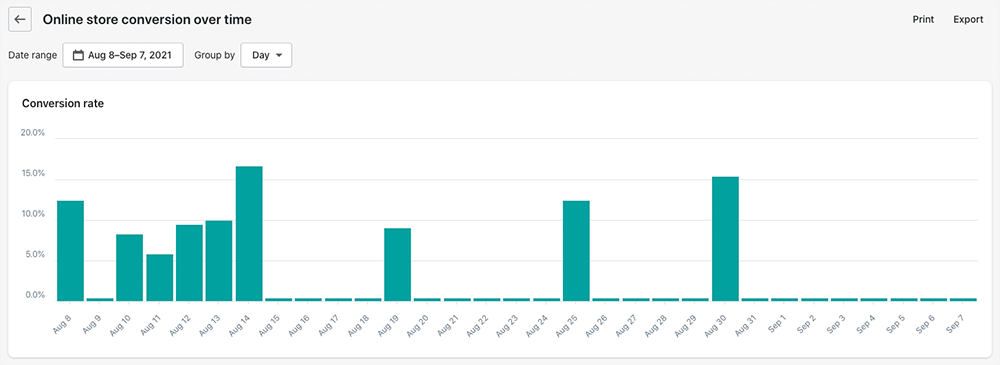
If you're new to ecommerce, y'all may detect GoDaddy's smart reporting assistant a less intimidating way to become to grips with analytics for your store — information technology makes analytics a fleck like playing a game.
However, for more professional reporting functionality and a greater range of options with which to crunch your information, the better choice (albeit at a more expensive price) is Shopify.
Integration with other apps
A fundamental departure between GoDaddy and Shopify is the extent to which you tin integrate the platforms with third-party tools, or add together bespoke functionality to your store.
Now, it'south fair to say that GoDaddy provides a lot of built-in functionality for design, marketing, payments, bookings, shipping, and SEO. It provides splendid integrations with the biggest online marketplaces. And, when information technology comes to social selling, it covers several of the main bases like Facebook, Instagram, Twitter and Google.
For a lot of merchants, this will be perfectly sufficient.
Only unlike about other popular east-commerce solutions, GoDaddy doesn't accept an app store that lets you buy add-ons that increase your shop'due south functionality, or integrate it with other tools and services.
Non merely is GoDaddy lacking an app store, but it also lacks any clear style to integrate with tools exterior the GoDaddy platform. A particular omission hither is the lack of an official integration for Zapier — a 'syncing' tool that lets apps work together, even when official integrations for them don't exist.
The opposite is true of Shopify. Its app store offers around 7,000 apps that allow yous to integrate the platform with a broad range of other services and add additional features to your store.
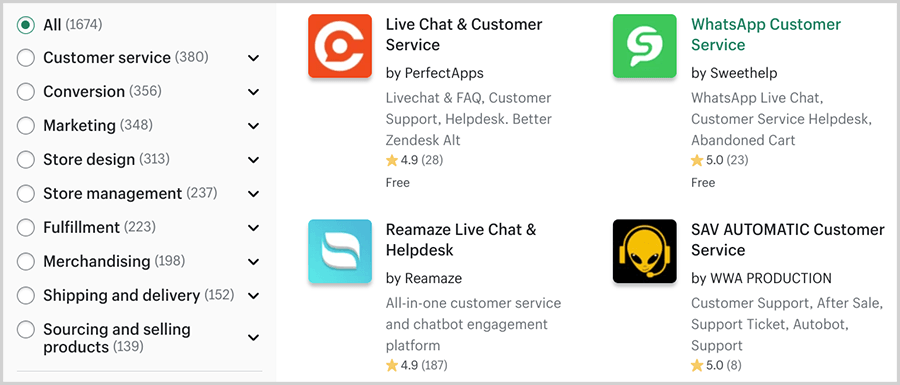
This provides sellers with a lot more versatility when it comes to things like:
- email marketing campaigns
- dropshipping
- reporting
- customer service.
In addition to the apps in the Shopify app store, Shopify also works with Zapier — adding over 4,000 integrations and automations to proceedings.
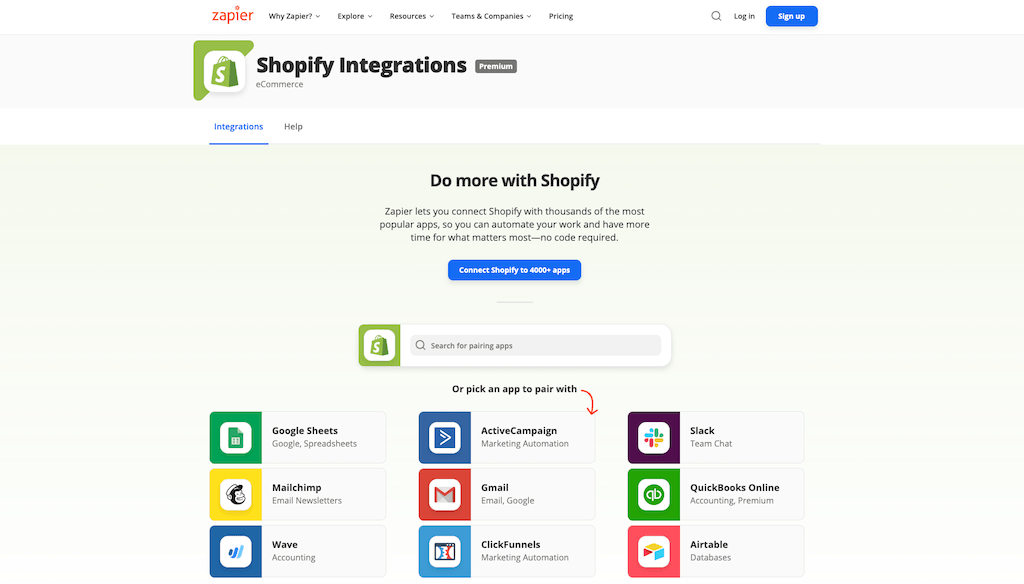
The bottom line is that Shopify gives ecommerce site owners significantly more access to tools and integrations with which to sell or promote their products than GoDaddy.
Forms and data capture
Both GoDaddy and Shopify provide the selection to add data capture forms (contact forms, newsletter forms etc.) to your store.
Nonetheless, despite Shopify'southward recent 'Online Store 2.0' update, the options for customizing forms on the platform remain fairly express — you're largely stuck with using default 'contact class' style fields — unless you resort to coding, or purchasing a third-party app (of which, to be fair, in that location are many).
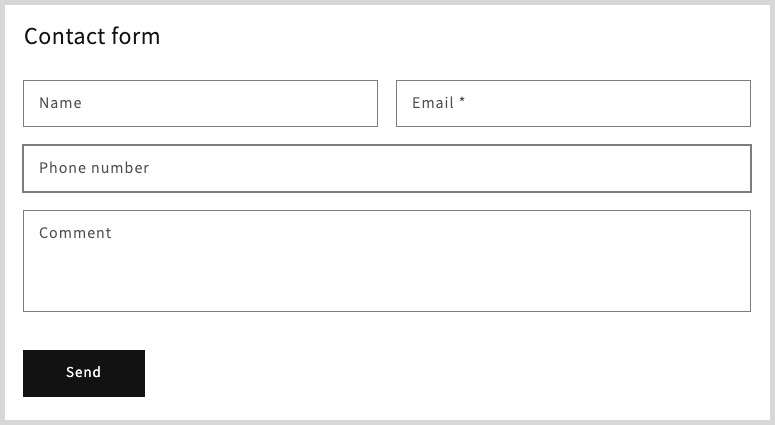
GoDaddy, on the other hand, does permit you lot to add custom fields hands enough using its form designer.
The key difference in the ii platforms' approaches to data capture is that Shopify enables you to send your data to more places; its app store provides integrations for fundamental electronic mail marketing campaign tools similar GetResponse, AWeber, Mailchimp and Entrada Monitor.
With GoDaddy, your form data is but sent to your store account — you can only actually make utilise of it via the congenital-in GoDaddy marketing tools.
So, it's fair to say that both platforms could provide a flake more than 'out of the box' functionality when it comes to edifice custom forms. Several other ecommerce platforms, Wix and Squarespace to mention two, offer more than 'bespoke' course creation options without a demand for coding or help from third-party apps.
Email marketing in GoDaddy and Shopify
A key part of running an ecommerce website is email marketing — sending due east-newsletters to your mailing listing is i of the all-time ways to generate sales.
So, in common with a lot of other ecommerce platforms, both GoDaddy and Shopify now offer built-in electronic mail marketing tools.
Both companies' offerings here are fairly similar in terms of functionality — you can use them to transport basic but professional-looking newsletters promoting your products, and this volition accommodate a lot of merchants perfectly well.
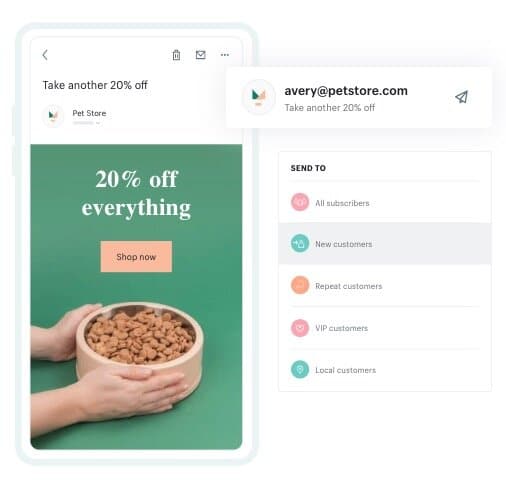
However, if you're looking for the sort of advanced autoresponder capabilities or marketing automation features that tools like AWeber and Mailchimp provide, you won't yet discover available in either platform yet.
The main divergence to focus on between the two platforms' out-of-the-box electronic mail marketing tools is less about functionality, and more nearly the ship limits: Shopify lets yous send up to2,500 emails per month for costless, with a $one fee applying to every additional 1,000 emails sent after that. GoDaddy is more generous: on its 'Ecommerce' plan, you tin send up to 25,000 emails per month.
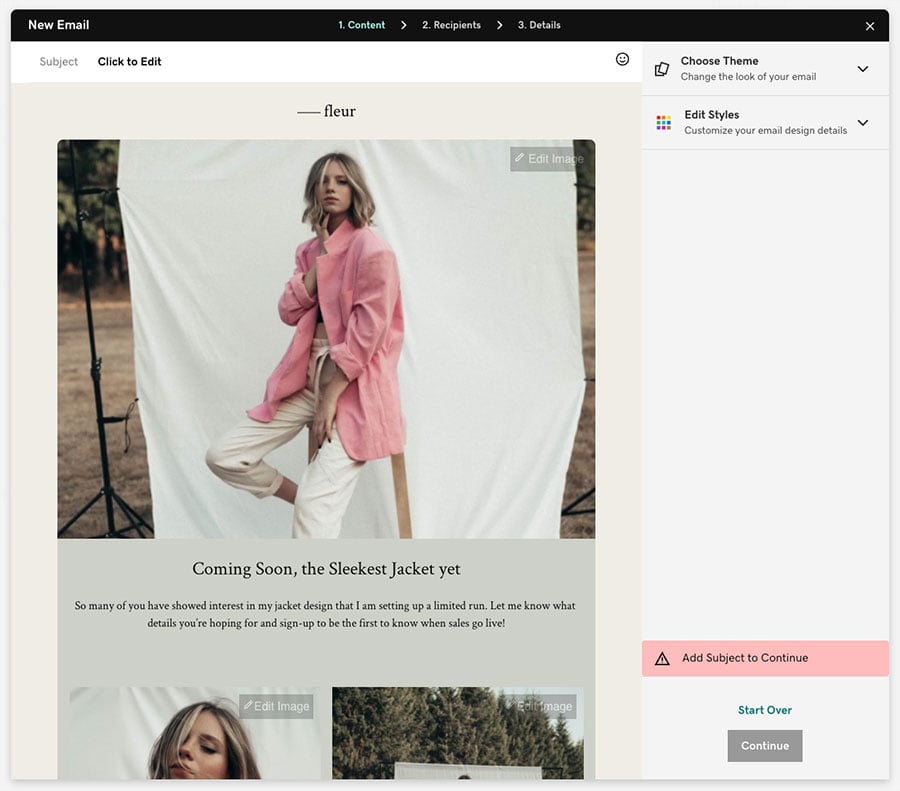
The other thing worth noting is that while GoDaddy'southward electronic mail marketing tool is firmly baked-in to its interface, using Shopify email marketing requires installing a free app — the appropriately named 'Shopify Electronic mail.'
Then compared to Shopify, I'd say that GoDaddy has the edge when it comes to congenital-in email marketing features — they are more generous in terms of send limits, and more easily attainable. All the same, because y'all can claw Shopify up to most email marketing platforms (which is not the instance with GoDaddy) yous could argue that Shopify ultimately offers more options when information technology comes to email marketing.
Search Engine Optimization (SEO)
SEO is a vital role of e-commerce — without organic traffic, you're going to suffer from a sales perspective. And so how do GoDaddy and Shopify stack up on this front?
GoDaddy SEO
Similar many of GoDaddy's website and store builder's other features, the SEO tools on offering from the platform are aimed at relative beginners.
GoDaddy'southward architect does certain of import SEO things well — it provides:
- a complimentary SSL certificate for every site, giving your site a secure, https:// connexion (something Google is very keen on)
- an automatically generated XML sitemap (this helps search engines crawl and index your pages more hands)
- fully responsive, mobile-friendly templates (Google's preferred approach to web blueprint)
- an like shooting fish in a barrel way to edit page meta descriptions (the site descriptions that appear in search results)
- access to 'culling text' tags for images (these help search engines — and people with a visual impairment — empathise your content better)
- a 99.9% uptime guarantee for your site.
A particularly useful aspect of GoDaddy's SEO feature set involves keywords.
The congenital-in 'optimization sorcerer' — available on the standard plan and higher — provides some very accessible step-past-stride assistance for working on your site's keywords and on-page content, looking at your content and making keyword suggestions for yous automatically.
In effect, it helps ensure that starting time-fourth dimension shop owners are (possibly without realizing it) optimizing page and product content across their site.
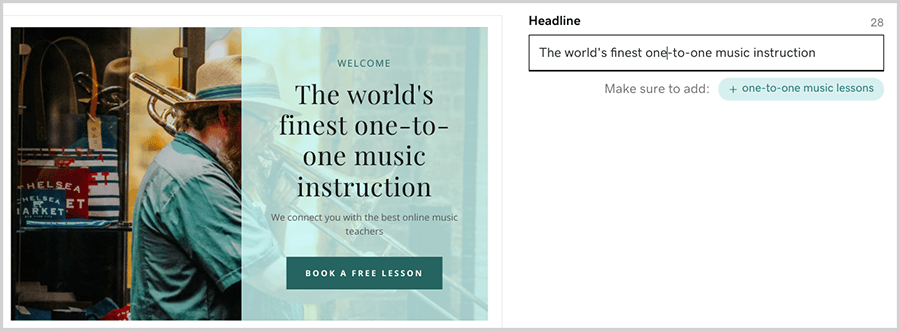
However, there are a few major limitations to GoDaddy's SEO features:
- In that location's no access to the lawmaking of your template (thus making information technology hard for you or a develop to customize your site in a way that will encounter Google's new Core Web Vitals requirements).
- GoDaddy provides limited editing of page URLs (Google looks at URL structure when categorizing content).
- You don't go any control over 301 page redirects (these are used to tell search engines what to index if an existing page gets renamed or deleted).
These omissions are not at all ideal and accept the potential to hold y'all back from an SEO perspective.
Shopify SEO
Dissimilar GoDaddy, Shopify allows you almost complete freedom when it comes to your site's SEO. The platform lets you configure just nigh any SEO element, including URL, redirects and page titles.
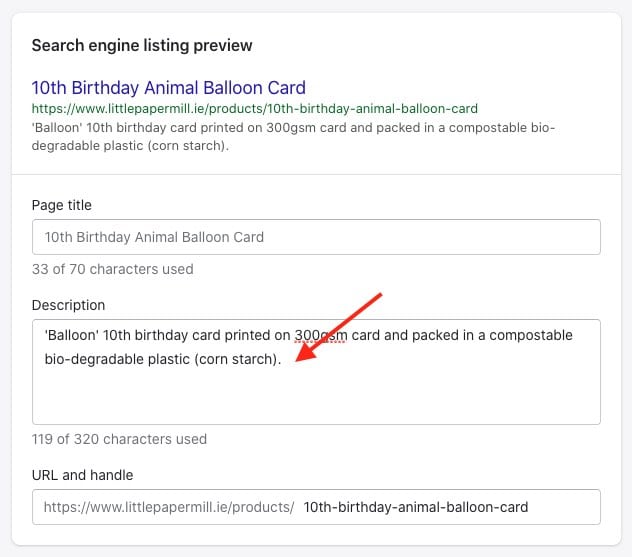
And if yous desire to improve your site's loading times and visual stability (two of Google'southward Core Spider web Vitals criteria), you can do this more easily in Shopify — either by modifying your site code or by using using an app from the Shopify app store to help you.
Another additional SEO benefit of Shopify is the fact that you can apply AMP — Accelerated Mobile Pages format (admitting with the assist of an app).
AMP format generates a stripped-down mobile version of your site that helps it load faster — and, as Google rewards faster-loading sites, being able to make use of this applied science tin can exist a large plus.
And speaking of loading speed, another useful characteristic in Shopify is its 'site speed' report. This dashboard-style study compares your site to similar stores in order to analyze where you tin can make improvements.
All in all, Shopify has a significant edge over GoDaddy when it comes to SEO.
Hiring GoDaddy to do your SEO
One thing about GoDaddy that might appeal to SEO novices is that y'all can pay GoDaddy to optimize your site for you via its 'SEO Services' offer. Pricing for this bespoke one-to-ane SEO service is negotiated based on your SEO needs.
Some store owners will be happy to hand-over their SEO work to GoDaddy. Merely as discussed above, if you want to exercise information technology all yourself, you'll find that the technical SEO features of GoDaddy are relatively basic in nature.
Please annotation: I am not a lawyer, and then the commentary below should non be taken as legal communication. For expert legal advice on GDPR and your ecommerce site, it is best to consult a lawyer.
The General Data Protection Regulation — GDPR for short — places legal obligations on website owners with regard to the privacy and data rights of Eu customers and site visitors. (Similar laws be in California and many other territories.)
The GDPR requires:
- safe and secure processing of customer information
- clearly-displayed privacy policies
- explicit consent to be given for mailing lists and newsletters
- consent to be given before non-essential cookies are run (for instance Facebook pixels, Google Analytics tracking code etc.).
It'south not too difficult to encounter almost of these requirements with GoDaddy or Shopify — but GoDaddy deals with the cookie consent issue improve than Shopify, giving you like shooting fish in a barrel access to a banner that lets your users have or refuse the use of non-essential cookies.
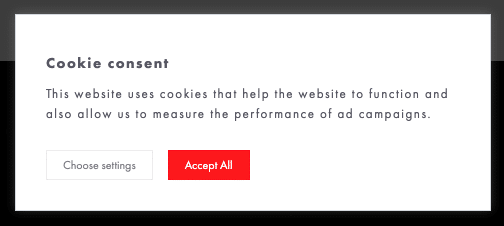
(However, one thing to note is that it is not clear how a visitor to your GoDaddy site can 'revoke' consent once he or she has accepted your cookies — and giving your users the ability to do so is as well a GDPR requirement).
Unfortunately, no born GDPR compliant cookie imprint available in Shopify — to get one you'll have to head over to the app store. There you'll notice over 100 cookie banner apps, with the paid-for apps offer more than circuitous functions and a greater degree of compliance.
Considering that the GDPR has been in effect for over three years at this signal, I personally feel that Shopify should offer a built-in cookie banner solution — ideally ane that doesn't crave store owners to customize code or pay extra.
So as things stand it's a bit of a win for GoDaddy here.
Client back up
Both GoDaddy and Shopify offer comprehensive customer support.
GoDaddy provides alive chat and phone support across all its plans. Phone back up is 24/7 in near regions (alive chat is 24/7 in all) and locating the visitor's contact number couldn't exist easier — y'all'll find information technology nether the 'contact usa' choice in the master card.
In addition, GoDaddy provides a support business relationship on Twitter also as a range of help center articles and video tutorials.
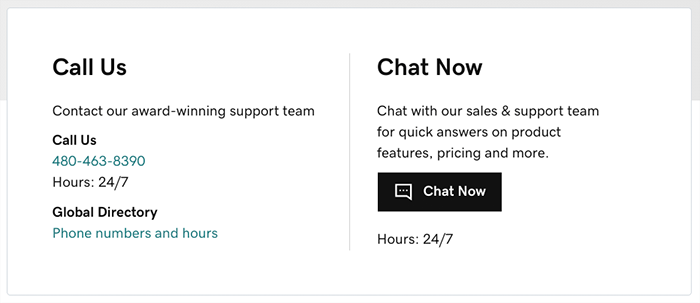
(A quick word of alarm about GoDaddy's help pages, withal: be sure that the help article you lot access is actually for the GoDaddy website and store builder tool. Information technology's quite piece of cake to discover you're reading an article that relates your search term simply is really well-nigh an entirely dissimilar GoDaddy product!)
As for Shopify'southward client support, you tin can avail of 24/vii live chat, 24/vii phone back up and e-mail.
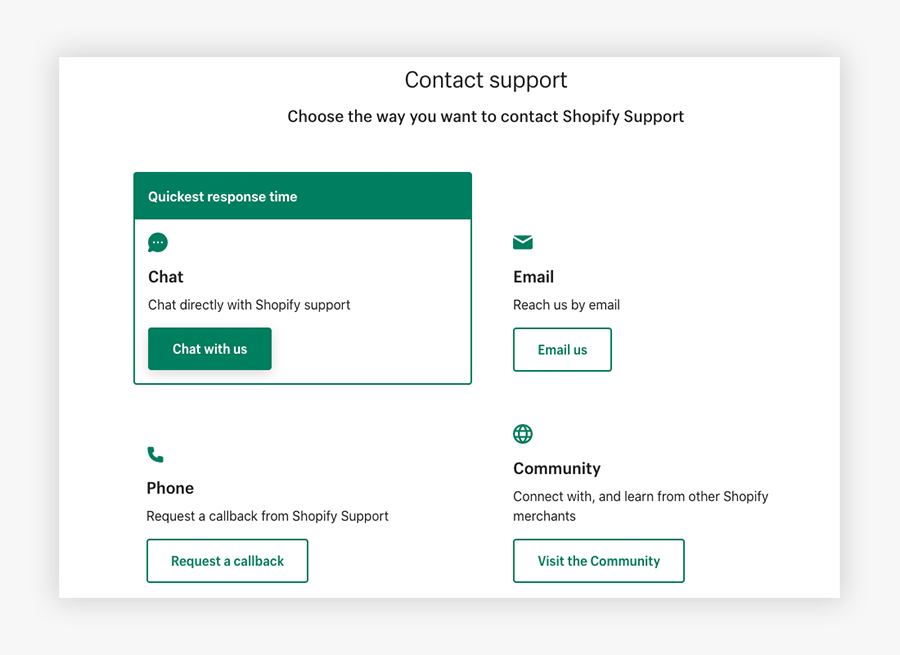
In terms of the telephone and email support, finding the Shopify contact details is only possible once you've already searched for an answer in the assistance center search facility. This makes GoDaddy the more immediately 'contactable' company of the ii.
Finally, with GoDaddy, if you take a trouble with your template, you lot're pretty much guaranteed to become the answers from its back up team directly. Withal, with Shopify, this is not always the case. For support with many of its paid-for templates you may have to contact the theme developer direct.
Overall, both Shopify and GoDaddy offer comprehensive support options — with GoDaddy being the more easily contacted of the two, but with Shopify offering more support channels.
Shopify vs GoDaddy: the verdict
Ultimately in a Shopify vs GoDaddy shootout, Shopify is the more powerful of the 2 platforms. Its much wider range of selling tools lets you create a more than sophisticated, bespoke online store; and its multilingual and multicurrency features give y'all the scope to scale your ecommerce business internationally in ways that are not possible with GoDaddy. Whereas GoDaddy is geared mainly towards solopreneurs and pocket-size business owners, Shopify caters for a much wider range of business types.
If you're an absolute due east-commerce beginner that simply needs to sell online in one currency and language, at that place is even so an argument for choosing GoDaddy: its user-friendliness, all-in-1 nature and its cheaper pricing may entreatment. But for professional person merchants, or those with ambitions to grow a meaning online business organization, Shopify is the improve option.
I'll sum up with some key pros and cons of both platforms — and the reasons why you lot might choose Shopify or GoDaddy equally the solution for your ecommerce project.
Reasons to use GoDaddy over Shopify
- You can use the platform entirely for free.
- Building a standalone online store costs less money with GoDaddy, and there are less hidden charges to worry about.
- All its themes are free — near of Shopify's range are paid-for.
- GoDaddy ecommerce features are really easy to utilise — novices may find the platform easier to hit the ground running with.
- It's easier to capture custom information for personalized products with GoDaddy.
- Its email marketing ship limit is considerably more generous than Shopify's.
- Backup and revision history features are included with GoDaddy, but not with Shopify.
- Its epitome editing tools are more powerful than Shopify's.
- It provides a built-in GDPR-compliant cookie banner tool; Shopify doesn't.
- GoDaddy doesn't apply transaction fees when you use a third-political party payment gateway; Shopify does.
- If you like that feeling of having 'everything under one roof', GoDaddy'due south platform may entreatment.
Reasons to utilize Shopify over GoDaddy
- You can sell an unlimited number of products on any Shopify program — but yous'll need to exist on the most expensive 'Commerce Plus' plan to do this with GoDaddy.
- You tin can sell online in multiple currencies and languages with Shopify; this is not really possible with GoDaddy.
- Shopify is a considerably stronger option for dropshipping.
- Its SEO features are much meliorate than GoDaddy's.
- Shopify's app shop makes it piece of cake to integrate the platform with a huge number of other services; GoDaddy doesn't actually offer annihilation comparable on this front.
- Because information technology works with more external payment gateways, you tin can employ more payment methods with Shopify.
- Shopify's reporting features are considerably more than extensive than GoDaddy'due south.
- Design customization options are far more extensive in Shopify than in GoDaddy.
- Y'all can connect a Shopify site to most of the major email marketing apps; GoDaddy restricts you lot to using its built in e-mail marketing selection.
- The point-of-sale features in Shopify are considerably stronger.
- Full HTML and CSS access is bachelor in Shopify.
- Shopify's automated sales tax features are excellent; none be for GoDaddy.
Alternatives to GoDaddy and Shopify
GoDaddy and Shopify aren't the but ecommerce platforms available — in that location are lots of other ecommerce solutions and website builders to consider!
A key alternative to GoDaddy and Shopify is BigCommerce — similar Shopify, it'south a dedicated ecommerce platform, rather than a more 'general' website builder, and accordingly it has a much larger set up of ecommerce features than GoDaddy. And, arguably, information technology boasts more 'out of the box' selling features than Shopify too.
Read our BigCommerce vs Shopify comparing or our BigCommerce review to find out more almost this platform.
Rather than using a hosted platform, an alternative way of selling online is to utilize an established online market place like Amazon or Etsy. Yous can read more most doing this in our Shopify versus Etsy and Shopify versus Amazon comparisons.
If you're not really focussed on ecommerce and you lot want to build a general-purpose website, it'southward worth taking a look at Squarespace and Wix — ii website builder platforms that combine a good range of ecommerce features with more full general website building tools. Check out our Wix review here; read our Squarespace review here; and learn nearly the Squarespace trial here.
WordPress is another great option for building an ecommerce website — but depending on whether yous use the hosted or self-hosted version, you lot may demand to factor in a scrap more configuration or development time if using this platform. Check out our Shopify vs WordPress mail for more than details.
Finally, you could consider Big Cartel every bit a budget option — information technology lets you sell up to 5 products completely complimentary. Y'all can read our Big Cartel vs Shopify comparing here or our full Big Cartel review here.
Shopify vs GoDaddy FAQ
Can I use GoDaddy and Shopify for gratis?
Yes. GoDaddy offers an entirely free plan, and Shopify offers a fourteen twenty-four hours gratuitous trial.
Which is easier to employ, GoDaddy or Shopify?
Thanks to its more than simplistic interface, GoDaddy is arguably easier to apply than Shopify. However, this is partly considering it has many less selling features.
Is GoDaddy skilful for ecommmerce?
The main argument for using GoDaddy as your commerce platform is that it is cheap, very piece of cake to utilise and comes with a good range of basic selling tools. Even so, information technology lacks many 'pro' features that you lot'd find in defended e-commerce platforms like Shopify, including the selection to sell in multiple currencies and languages. And due to its lack of an official app shop or Zapier integration, information technology's hard to become GoDaddy to integrate with other key e-commerce applications.
Is information technology easy to switch from GoDaddy to Shopify?
How complex a job this will exist will depend largely on on how many products yous have in your shop, and how much other content y'all have on your site — but in most cases, switching from GoDaddy to Shopify is pretty straightforward. You will need to export your products to CSV format first (for import into Shopify), and re-create and paste any pages blog posts you desire to move beyond.
Shopify vs GoDaddy: over to you!
Got any thoughts virtually Shopify vs GoDaddy? Or whatsoever questions we tin can help with? But go out a comment beneath.
Source: https://www.stylefactoryproductions.com/shopify-vs-godaddy
0 Response to "Uploading Products to Godaddy Site Store From Template"
Post a Comment